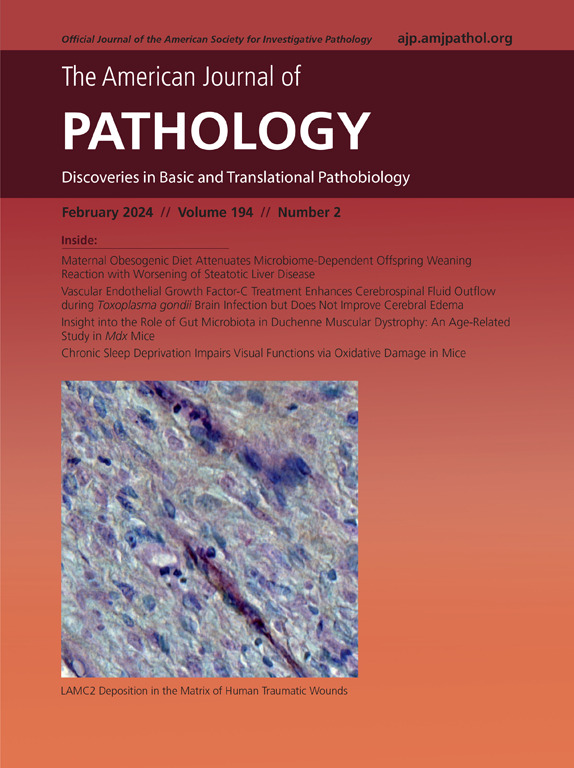经典和非经典单核细胞都会巡逻肾小球毛细血管,并促进急性肾小球炎症。
IF 4.7
2区 医学
Q1 PATHOLOGY
引用次数: 0
摘要
在血管中巡逻的单核细胞主要是非经典单核细胞亚群。然而,最近一项对肾小球微血管的研究提供了证据,证明经典和非经典单核细胞都会经历血管内滞留和迁移期。尽管如此,这些亚群是否会对急性肾小球炎症产生不同的影响尚不清楚。本研究利用肾小球多光子显微镜研究了经典和非经典单核细胞巡视肾小球微血管和促进急性中性粒细胞依赖性肾小球炎症的能力。在单核细胞报告基因 Cx3cr1gfp/+ 小鼠的成像实验中,用抗 Ly6B 或抗 Ly6C 联合染色显示,非经典(CX3CR1-GFP+)和经典(CX3CR1-GFP+ & Ly6B+ 或 Ly6C+)单核细胞都会在肾小球微血管中进行长时间(> 10 分钟)的滞留和迁移。诱导急性肾小球肾炎会增加经典单核细胞的这些行为,但不会增加非经典单核细胞的这些行为。利用非经典单核细胞缺陷的 Csf1rCreNr4a1fl/fl 小鼠或抗-CCR2 来清除经典单核细胞,清除任何一个亚群都会减少中性粒细胞在急性炎症肾小球中的滞留和活化,而通过抗-CCR2 处理 Csf1rCreNr4a1fl/fl 小鼠来清除这两个亚群,则会进一步降低中性粒细胞的活性。相反,在 CD4+ T 细胞依赖性肾小球肾炎模型中,任一单核细胞亚群的耗竭都不能改变中性粒细胞的反应。这些研究结果表明,经典和非经典单核细胞都会巡视肾小球微血管,并能促进急性炎症肾小球的中性粒细胞反应。本文章由计算机程序翻译,如有差异,请以英文原文为准。
Both Classical and Non-Classical Monocytes Patrol Glomerular Capillaries and Promote Acute Glomerular Inflammation
Monocyte patrolling of the vasculature has been ascribed primarily to the non-classical monocyte subset. However, a recent study of the glomerular microvasculature provided evidence that both classical and non-classical monocytes undergo periods of intravascular retention and migration. Despite this, whether these subsets contribute differentially to acute glomerular inflammation is unknown. This study used glomerular multiphoton intravital microscopy to investigate the capacity of classical and non-classical monocytes to patrol the glomerular microvasculature and promote acute, neutrophil-dependent glomerular inflammation. In imaging experiments in monocyte reporter Cx3cr1gfp/+ mice, co-staining with anti-Ly6B or anti-Ly6C revealed that both non-classical monocytes [CX3 chemokine receptor 1–green fluorescent protein positive (CX3CR1-GFP+)] and classical monocytes (CX3CR1-GFP+ and Ly6B+ or Ly6C+) underwent prolonged (>10 minutes) retention and migration in the glomerular microvasculature. On induction of acute glomerulonephritis, these behaviors were increased in classical, but not non-classical, monocytes. Using non-classical monocyte–deficient Csf1rCre Nr4a1fl/fl mice, or anti-CCR2 to deplete classical monocytes, the removal of either subset reduced neutrophil retention and activation in acutely inflamed glomeruli, while the depletion of both subsets, via anti-CCR2 treatment in Csf1rCre Nr4a1fl/fl mice, led to further reductions in neutrophil activity. In contrast, in a model of CD4+ T cell–dependent glomerulonephritis, the depletion of either monocyte subset failed to alter neutrophil responses. These findings indicate that both classical and non-classical monocytes patrol the glomerular microvasculature and promote neutrophil responses in acutely inflamed glomeruli.
求助全文
通过发布文献求助,成功后即可免费获取论文全文。
去求助
来源期刊
CiteScore
11.40
自引率
0.00%
发文量
178
审稿时长
30 days
期刊介绍:
The American Journal of Pathology, official journal of the American Society for Investigative Pathology, published by Elsevier, Inc., seeks high-quality original research reports, reviews, and commentaries related to the molecular and cellular basis of disease. The editors will consider basic, translational, and clinical investigations that directly address mechanisms of pathogenesis or provide a foundation for future mechanistic inquiries. Examples of such foundational investigations include data mining, identification of biomarkers, molecular pathology, and discovery research. Foundational studies that incorporate deep learning and artificial intelligence are also welcome. High priority is given to studies of human disease and relevant experimental models using molecular, cellular, and organismal approaches.

 求助内容:
求助内容: 应助结果提醒方式:
应助结果提醒方式:


